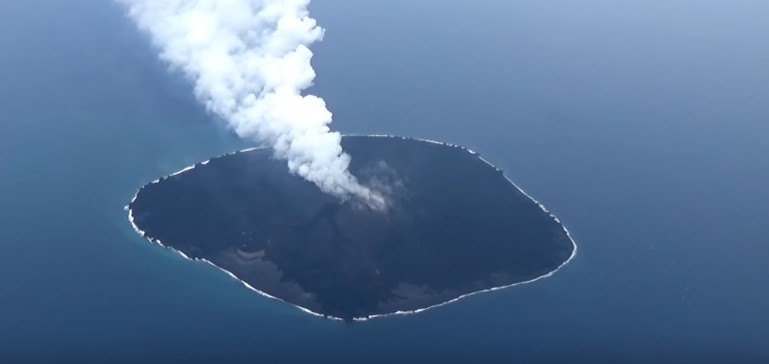At least 2 new craters formed during new Nishinoshima eruption

After one and a half year of quiescence, Japan's Nishinoshima volcano entered a new eruptive phase on April 20, 2017, and aerial imagery now shows there are at least two new craters spewing large amounts of lava. The latest eruptions at the volcano are classified as Strombolian type eruptions that comprise a series of outbursts of cinders and clumps of lava.
"The volcanic activity is certainly lively, as at least two craters have newly formed," Fukashi Maeno, volcanic geology professor at the University of Tokyo’s Earthquake Research Institute told Yomiuri Shimbun. "I think the island will expand more," he said.
From the Yomiuri Shimbun aircraft, eruptions could be seen occurring about dozens of seconds apart on Tuesday, April 25 with clumps of lava and gray smoke rising hundreds of meters into the air from the craters. A stream of glowing lava was also seen forking toward the west and the south sides of the island. On the west side, the lava was observed reaching the sea.
In November 2013, Nishinoshima erupted above sea level for the first time in 40 years, and grew dramatically outward from a central pyroclastic cone and other vents with extensive lava flows, Strombolian eruptions, and ash plumes that rose as high as 1.2 km (0.74 miles) in 2014. The area of the island grew from approximately 0.29 km2 (0.11 mi2) to 2.29 km2 (0.88 mi2) during 2014, reaching an elevation of around 100 m (330 feet) according to the Japan Coast Guard.
Active growth due to lava flows erupting from vents around the central pyroclastic cone continued through mid-November 2015 when the eruption ended. Observations by the JCG showed that lava flows stopped sometime between November 12 and 17, the last MODVOLC thermal alert was on November 14, and MIROVA data showed a drop in energy output a few days later. Ash plumes from explosions were still occurring on November 17, but no eruptive activity was seen during a December 22 visit. Monthly overflights by the JCG documented the growth of the island, which ended the year with an area of approximately 2.63 km2 (1.01 mi2).
Geological summary
The small island of Nishinoshima was enlarged when several new islands coalesced during an eruption in 1973-74. Another eruption that began offshore in 2013 completely covered the previously exposed surface and enlarged the island again. Water discoloration has been observed on several occasions since.
The island is the summit of a massive submarine volcano that has prominent satellitic peaks to the S, W, and NE. The summit of the southern cone rises to within 214 m of the sea surface 9 km SSE. (GVP)
Featured image: Nishinoshima erupting on April 25, 2017. Credit: Asahi Shimbun

Commenting rules and guidelines
We value the thoughts and opinions of our readers and welcome healthy discussions on our website. In order to maintain a respectful and positive community, we ask that all commenters follow these rules.